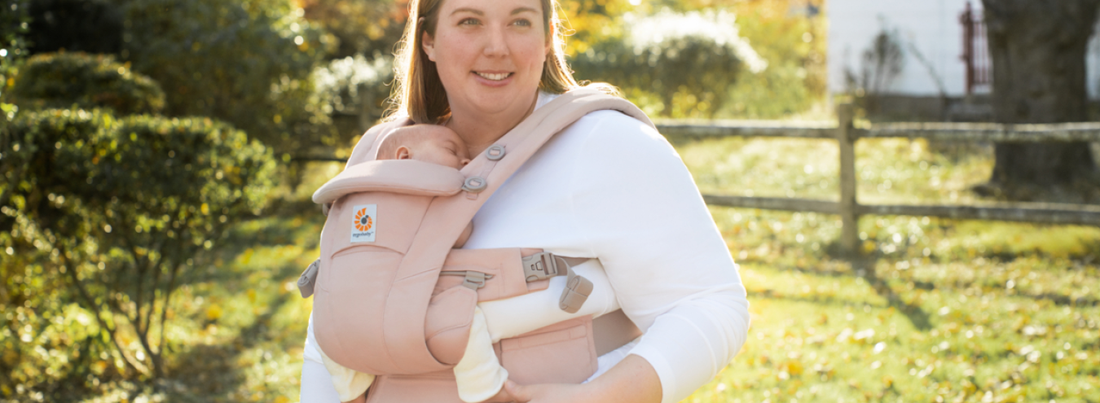When you carry your child in a baby carrier, ergonomics is crucial for both you and the child to have a comfortable and safe experience. Ergonomics is about finding the best possible position to reduce strain on the body and support natural development – and this applies to both you as the carrier and your child. Ergobaby's carriers are designed to provide optimal support and relief, allowing you to carry your child for longer periods without straining your body.
Ergonomic carrying position for the child
The most fundamental aspect of an ergonomic baby carrier is that it supports the child's natural posture and movements. When the child is seated in a baby carrier, it should be placed in what is called the "M-position." In this position, the child's knees are higher than the bottom, with the legs spread wide apart and the hips in a natural, bent angle. This promotes healthy development of the hip joints, especially for newborns and small children, where the hip joints are still developing.
What is the "M-position"?
- Knees higher than the bottom: The child's knees should be positioned slightly higher than their hips.
- Legs spread apart: The hips should be in a natural position where the legs extend out to the sides of the child's body.
- Close to the parent's body: The child should be held tightly against the carrier, so that their back maintains a slight curve (C-shape), which supports the spine naturally.

This position helps to distribute the child's weight evenly and reduces the risk of hip dysplasia, a condition where the hip joints do not develop correctly.
Ergonomic comfort for the parent
It's not just the child that needs to be supported correctly. As a parent or caregiver, it's important that the baby carrier helps to relieve your body, especially the shoulders, back, and hips. Ergobaby's carriers have wide, padded shoulder straps and a supportive waist belt that help distribute the child's weight across your entire upper body, rather than placing all the burden on the shoulders.

Advantages of Ergobaby's ergonomic design:
- Waist Belt: A sturdy and adjustable waist belt provides support for the lower back and relieves pressure from your shoulders.
- Padded shoulder straps: Help distribute the child's weight and prevent the shoulders from becoming overloaded.
- Even weight distribution: By spreading the weight over both hips and shoulders, the risk of fatigue and discomfort during prolonged use is reduced.

Adaptable carrying positions
One of the major advantages of Ergobaby's baby carriers is their versatility in terms of carrying positions. Many of their models offer several different positions, allowing you to adjust the carrying based on your child's age and preferences.
The most common carrying positions:
- Magposition (facing inward towards you): Perfect for newborns and younger children. This position provides the child with security and closeness while supporting the spine and neck.
- Magposition (facing outward): When the child is a little older and starts to become curious about the world, you can use this position to let the child explore their surroundings while maintaining the ergonomic M-position.
- Back position: For parents carrying heavier or older children, the back position can be more comfortable and relieving.
- Hip position: An option that can be comfortable for carrying moments that allows the child to rest on your hip, with eye contact and free movement for you, the so-called triangular carrying position.
Why is ergonomics important?
Ergonomic design is not just a matter of comfort, but also of safety and development. When you carry your child in an ergonomic way, you promote healthy growth of their skeleton and muscles, especially for the hips, back, and neck. An ergonomically designed baby carrier also protects the child from overloading certain parts of the body, which can prevent long-term problems.
For you who carry, ergonomics is just as important. A poorly designed baby carrier can lead to back pain, shoulder tension, and other discomforts. Therefore, it is important to choose a baby carrier that is designed to provide support for both you and your child.
Ergonomic baby carriers from Ergobaby
Ergobaby's range includes several models that are ergonomically designed, including their popular Omni Breeze, Omni Dream and Embrace. These models offer the ergonomic M-position and support for both child and parent. Additionally, they have adjustable straps and waist belts, allowing them to be adapted to your body type and your child's growth.
In summary, ergonomics in baby carriers is about creating a healthy, comfortable, and safe carrying environment for both the child and the wearer. With the right support, you and your child can enjoy many carrying moments together, whether you are at home or out exploring the world.







